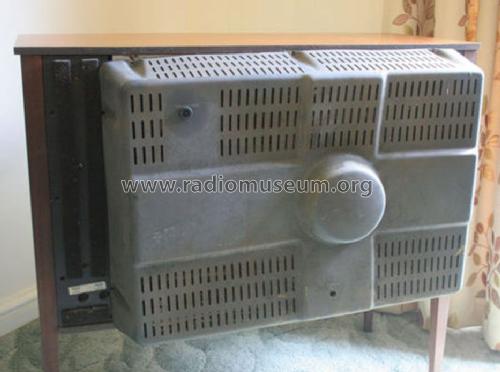Dual Standard Colour TV G25K500 Ch= G6
Philips Electrical, Lamps, Industrial - Miniwatt; London
- Land
- Grossbritannien (UK)
- Hersteller / Marke
- Philips Electrical, Lamps, Industrial - Miniwatt; London
- Jahr
- 1967
- Kategorie
- Fernseh-Empfänger/Monitor
- Radiomuseum.org ID
- 221228
- Anzahl Röhren
- 22
- Röhren
- PCF802 PCL86 EF183 EF184 EF184 PCC85 PCC85 PFL200 PCF200 PCF200 PCF200 EF80 ECC81 PCC85 PL508 PCF802 PL509 PY500 GY501 PD500 EY51 A63-11X
- Anzahl Transistoren
- 17
- Halbleiter
- AF239 AF139 AF139 BF194 BF194 BF167 BF167 BF173 BF173 BC108 BC108 BC108 BF195 BF195 BF194 BF194 BC107 BY100 BA148 BYX10
- Hauptprinzip
- Superhet allgemein
- Wellenbereiche
- VHF/UHF (siehe Bemerkungen)
- Betriebsart / Volt
- Wechselstromspeisung / 240 Volt
- Lautsprecher
- Dynamischer (permanent) Ovallautsprecher
- Material
- Gerät mit Holzgehäuse
- von Radiomuseum.org
- Modell: Dual Standard Colour TV G25K500 Ch= G6 - Philips Electrical, Lamps,
- Form
- Standgerät auf niedrigen Beinen (Beine < 50 % der Gesamthöhe).
- Abmessungen (BHT)
- 34 x 32.75 x 21.75 inch / 864 x 832 x 552 mm
- Bemerkung
- The Philips Dual Standard Colour TV G25K500 is equipped with the G6 colour television chassis and a 25" shadow-mask CRT. It is designed for reception of both colour and monochrome pictures on 625-lines, and monochrome pictures on 405-lines. For colour reception, the PAL de-luxe system is employed, using a glass delay line in the crominance channel to give best quality of colour and easier tuning.
Channels
405-line: Channels 1 to 3 - Band 1A
405-line: Channels 3 to 5 - Band I
405-line: Channels 6 to 13 - Band III
625-line: Channels 21 to 69 - Bands IV and V.
Cabinet presentation
Natural oiled teak-veneered cabinet with matching detachable legs and forward facing loudspeaker. Control panel in linished silver with black and silver sun-spun knobs.
- Datenherkunft
- -- Original-techn. papers.
- Autor
- Modellseite von Dave Evans angelegt. Siehe bei "Änderungsvorschlag" für weitere Mitarbeit.
- Weitere Modelle
-
Hier finden Sie 427 Modelle, davon 305 mit Bildern und 286 mit Schaltbildern.
Alle gelisteten Radios usw. von Philips Electrical, Lamps, Industrial - Miniwatt; London


